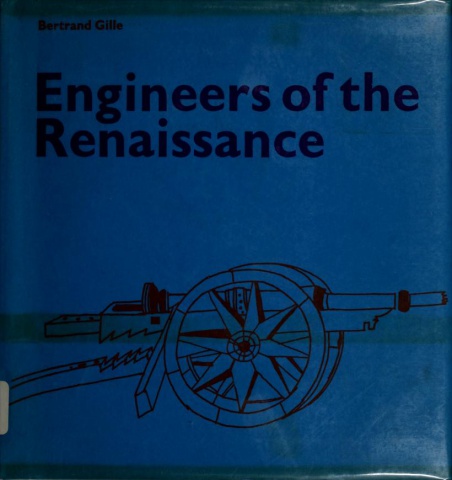Bertrand Gille: Engineers of the Renaissance (1964–) [French, English]
Filed under book | Tags: · art, art history, engineering, history of science, history of technology, machine, mechanics, renaissance, science, technology

“In his reconstruction of Renaissance technology informed by research into little-known manuscripts from libraries across Europe, Bertrand Gille emphasises the close continuity of technical invention from antiquity (in particular, the Alexandrian Greeks), through the mediaeval period (in particular, the Germans), to its brief but brilliant high flaring among the Italians of the fifteenth century. The engineers were conscious of embodying the Archimedean tradition, the tradition of “give me a place to stand and I can move the world.” It was an age marked by a close and natural mutuality between the technical and the fine arts, and by the first real union of science and technology, whose issue was a permanent enrichment of both. Science gave to engineering a new sophistication of mathematical precision, and the working models constructed for mechanical inventions prepared the way for a truly experimental science, as later developed by the generation of Galileo.
As might be expected, the figure of Leonardo da Vinci looms large in this book. It is the author’s contention, based on the documents he has uncovered, that Leonardo’s originality as an engineer has been greatly overestimated, that in fact he borrowed and adapted freely from the work of this anonymous and little-known contemporaries, that many of his ideas are already prefigured in the mediaeval period. Nevertheless, although he rests on the foothills leading up to him, he still towers above them as the consummate technical artist.”
Publisher Hermann, Paris, 1964
239 pages
English edition
Publisher MIT Press, 1966
256 pages
Reviews: Alex Keller (Technology and Culture, 1965), Harry Woolf (Science, 1968), M. Daumas (Revue d’Histoire des sciences et de leurs application, 1964, FR).
Wikipedia (FR)
Les ingénieurs de la Renaissance (French, 1964, 8 MB, added on 2018-12-27)
Engineers of the Renaissance (English, 1966, 8 MB, updated on 2018-12-27)
Lewis Mumford: Art and Technics (1952–) [English, Greek]
Filed under book | Tags: · architecture, art, city, craft, machine, mechanics, technology

Lewis Mumford — architectural critic, theorist of technology, urbanist, cultural critic, historian, biographer, and philosopher — was the author of almost thirty books, many of which expounded his views on the perils of urban sprawl and a society obsessed with “technics.”
In these lectures delivered at Columbia University in 1951, Mumford explores “the ethical problems that drove all of his writings on art, technology and urbanism: the severing of the bonds of fellowship and community in advanced industrial society; the waning sense of a public good and the resulting moral crisis of modern life; the cultural divide separating an instrumental language of technique from the symbolic language of aesthetic experience; and the plight of ‘personality’ in a bureaucratic age.” (from the introduction to the 2000 edition)
Publisher Columbia University Press, New York, 1952
Bampton Lectures in America, 4
162 pages
Review (R. L. A., Philosophy of Science, 1953)
Art and Technics (English, 1952, removed on 2019-10-3 upon request from publisher)
Τέχνη και τεχνική (Greek, trans. Βασίλης Τομανάς, 1997)
Hillel Schwartz: The Culture of the Copy: Striking Likenesses, Unreasonable Facsimiles, 2nd ed. (1996/2013)
Filed under book | Tags: · animal, appropriation, art, children, computing, copy, death, fashion, film, gender, genetics, history, imitation, japan, language, machine, memory, music, photography, piracy, property, reenactment, reproduction, sculpture, simulation, slavery, statistics, surgery, technology, theatre, time, war

The Culture of the Copy is an unprecedented attempt to make sense of the Western fascination with replicas, duplicates, and twins. In a work that is breathtaking in its synthetic and critical achievements, Hillel Schwartz charts the repercussions of our entanglement with copies of all kinds, whose presence alternately sustains and overwhelms us. Through intriguing, and at times humorous, historical analysis and case studies in contemporary culture, Schwartz investigates a stunning array of simulacra—counterfeits, decoys, mannequins, and portraits; ditto marks, genetic cloning, war games, and camouflage; instant replays, digital imaging, parrots, and photocopies; wax museums, apes, and art forgeries, not to mention the very notion of the Real McCoy. Working through a range of theories on biological, mechanical, and electronic reproduction, Schwartz questions the modern esteem for authenticity and uniqueness. The Culture of the Copy shows how the ethical dilemmas central to so many fields of endeavor have become inseparable from our pursuit of copies—of the natural world, of our own creations, indeed of our very selves.
This updated edition takes notice of recent shifts in thought with regard to such issues as biological cloning, conjoined twins, copyright, digital reproduction, and multiple personality disorder. At once abbreviated and refined, it will be of interest to anyone concerned with proglems of authenticity, identity, and originality.
First published in 1996
Publisher Zone Books, New York, 2013
ISBN 1935408453, 9781935408451
480 pages
Review (Terence Hawkes, London Review of Books, 1997)
Review (Francis Kane, The New York Times, 1997)
Review (Todd Gitlin, Los Angeles Times, 1997)
Download (removed on 2014-3-20 upon request of the publisher)
Comment (1)
